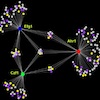 Structure of the transcriptional network controlling white-opaque switching in Candida albicans
Structure of the transcriptional network controlling white-opaque switching in Candida albicansHernday AD, Lohse MB, Fordyce PM, Nobile CJ, Derisi JL, Johnson AD
Mol Microbiol, 2013Abstract: The human fungal pathogen Candida albicans can switch between two phenotypic cell
types, termed 'white' and 'opaque'. Both cell types are heritable for many
generations, and the switch between the two types occurs epigenetically, that is,
without a change in the primary DNA sequence of the genome. Previous work
identified six key transcriptional regulators important for white-opaque
switching: Wor1, Wor2, Wor3, Czf1, Efg1, and Ahr1. In this work, we describe the
structure of the transcriptional network that specifies the white and opaque cell
types and governs the ability to switch between them. In particular, we use a
combination of genome-wide chromatin immunoprecipitation, gene expression
profiling, and microfluidics-based DNA binding experiments to determine the
direct and indirect regulatory interactions that form the switch network. The six
regulators are arranged together in a complex, interlocking network with many
seemingly redundant and overlapping connections. We propose that the structure
(or topology) of this network is responsible for the epigenetic maintenance of
the white and opaque states, the switching between them, and the specialized
properties of each state.
